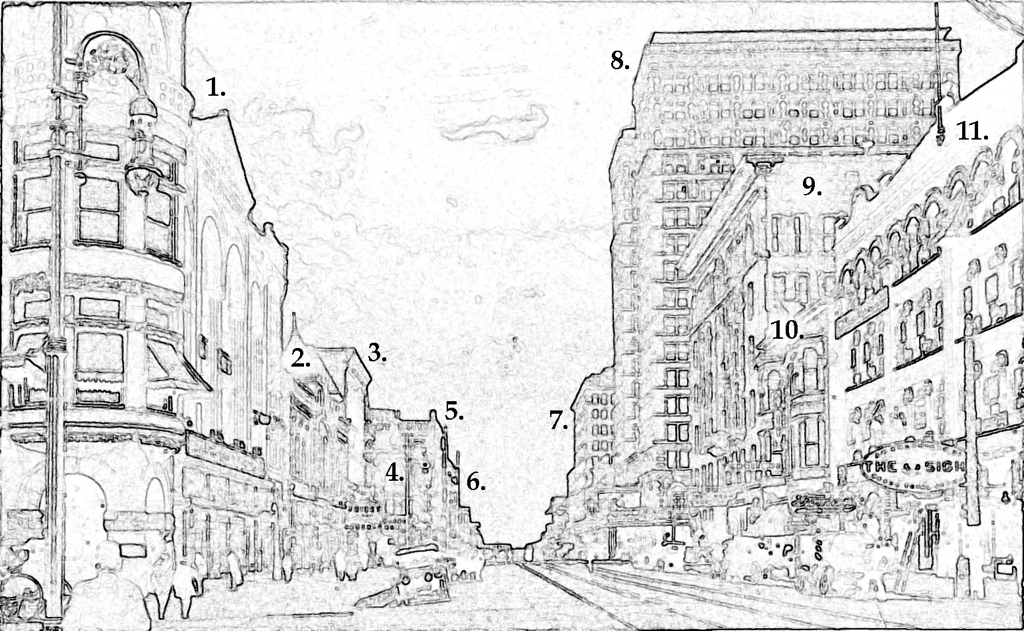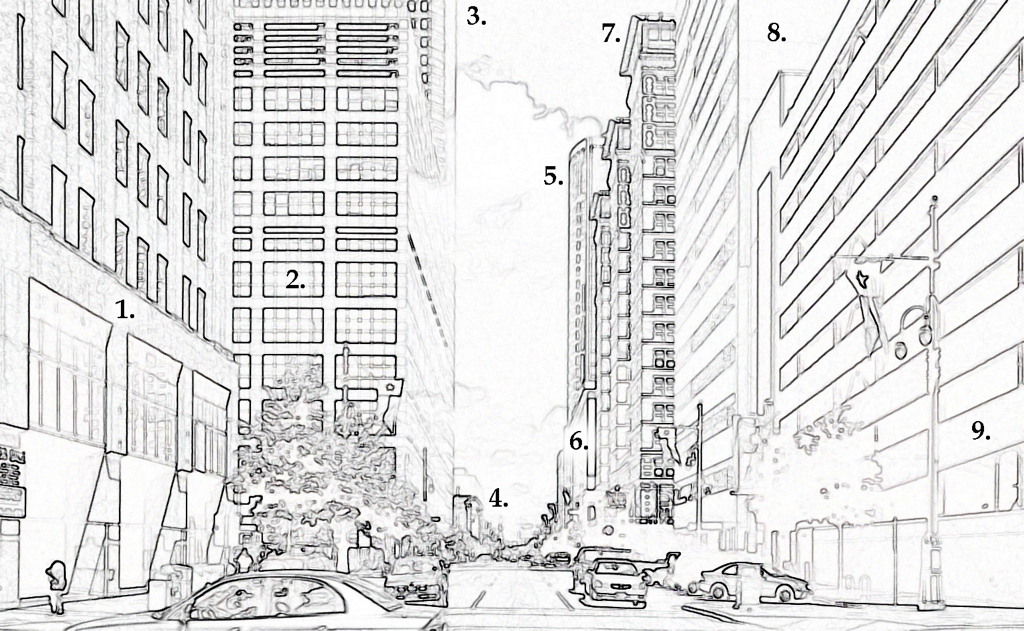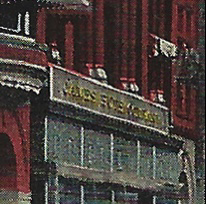Armory
|
12 May 1922: 1. 1016-22 Texas: The Houston Light Guard Armory Building (chartered 1873), 3 floors and a tower, 1890-1928, including bowling alleys, billiard parlor, ladies lounge, drill hall - The Guard was organized by Confederate veterans after the Reconstruction in 1873, and was active in restoring the peace after race crises, political feuds, labor strikes, the Galveston Hurricane, a yellow fever quarantine strike, and other breakdowns of law and order. It was sold by the Guard in 1925 and a new building was built at 3816 Caroline Street; 2. 1010 Texas: Frisco Lines, city ticket office; St. Louis, Brownsville & Mexico Ry, city office; Morgan Steamship Lines / 1012 Texas: Jon. McCleland Co., crockery / 1014 Texas: F. J. Rodney carpets, John Stagno, shoemaker; 3. 1006-1008 Texas: Houston Electric Co., Houston’s extensive trolley line; The Interurban (Galveston Houston Electric Ry Co.) gen'l offices, depot and ticket office / 1010 Texas Frisco Lines, city tkt office; St. Louis, Brownsville & Mexico Ry, city office; Morgan Steamship Lines; 4. 601-3 Main: Wicks & Company ice cream parlor and soda fountain operated by Moye Wicks, Theodore Frank’s fruit stand (who lived on-site), and one of J. N. Taub's numerous cigar stands (See also Texas at Fannin - W); 5. 900-908 Texas: Milby Hotel, 6 floors, 1910-1971; 6. 602 Travis: Post Building, 4 floors, 1904; 7. 518-20 Travis: The Chronicle Building, 10 floors, 1910; 8. 518-520 Main: Rice Hotel, 17 floors, opened 1913; 9. 513-19 Main: Binz Building, 6 floors, 1895 (demolished 1951); 10. 1009-11 Texas: Smith Ed C. furniture store; 11. 1013-19 Texas: Moore-Burnett Bldg. Marquee: "Foman & Co.", tailor shop in room 403 operated by John G. Foman (1864-1937), an immigrant from Bohemia, and Victor H. Roos (1875-1929, an immigrant from Sweden). / Marquee: "J. G. Eganhouse Optical ... The eye ... Everything Optical" the office of Dr. John G. Eganhouse (1875-1963), 1017 Texas. Other offices in the building were for physicians, dentists, oil well suppliers, real estate and insurance agents, civil engineers, and somewhat unexpectedly, a number of artist professionals: Mrs. Helen Curtiss, music teacher; Mrs. Emma J. Bujac, music teacher; Mrs. Bonnie W. Moseley, artist; Mrs. Perle Evans Barber, elocutionist; Mrs. Mollie S. Jones, art needlework; Salomon & Lehman, artists; Mrs. Hattie V. Y. Palmer, china painting; E. W. Irish Photo Co.
|
10 July 2004: 1. 608 Fannin: Sterling Building (Texas Tower) built by Texas Governor Ross S. Sterling, who in 1928 purchased the Armory (then occupied by the James Bute Paint store), 21 floors, 1931 (demolished May 2014 and replaced by Hines North Tower at Main 609, 48 floors, developed by Gerald D. Hines (1925-2020) featuring a sharply angled roof-line which evokes Hines' earlier Pennzoil Place, and including a 13 level parking structure facing Texas Avenue here); 2. 601 Travis: JPMorgan Chase Center, 20 floors, 1982; 3. 600 Travis: JP Morgan Tower (Texas Commerce), 75 floors, 1982; 4. 615 Louisiana: Jesse H. Jones Hall for the Performing Arts, 1964-66; 5. 717 Texas: Calpine Center, 34 floors, 2003; 6. 518-20 Travis: The Chronicle Building, 10 floors, 1910 (demolished in 2017 to be replaced by The Texas Tower, 845 Texas Avenue, 47 floors, 2018-2021); 7. 909 Texas: Rice Hotel, 17 floors, opened 1913, 3rd wing added in 1925, 18th floor added 1951; 8. 1001 Texas: Binz Building, 13 floors, 1982 (the third by the same name on the site, the first 1895-1951, the second 1951-1981); 9. 1015 Texas: Binz Building Parking Garage, 9 floors, 1991.
|
|
To: Miss Dorothy McLey
424 North Weber Colorado Springs, Colo. Postmarked: Houston 2 Texas May 12, 1922 Stamp: 1c Green George Washington #405 From: J. W. Mc. Message: Houston Texas May 12 - 1922 Dear Folks Just a line to let you know that I have not melted entirely yet. We are going to Sylvan Beach to night. They are running two special trains for us. The mosquitos about eat us up last night. Them and roaches seem to be the principle product of this part of Texas J. W. Mc. |
15,000 Firemen and Engineers descended on Houston in early May, 1922 for a convention, including Jacob Wallace McLey,a steam railroad engineer from Goodland, KS. As a railroad man, he certainly did appreciate the efforts that his Houston hosts had made to take so many to Sylvan Beach on special trains. When he mentioned mosquitos and roaches, loathsome talismans of disease, it was to highlight the unhealthy climate of the Gulf Coast in contrast with the salubrious character of Colorado. In another more upbeat postcard written May 29th from Fort Worth R. P. O. [Railway Post Office], most probably on the way back home to Colorado Springs, he tells his daughter about the 3 hour and 20 minute cruise he took into Galveston Bay on board the “Good Boat Nicolas.” He mentions an oil field he saw from the water, and several big freighters, “One from Balboa,” and others from New York and New Orleans. He was obviously very impressed with the commerce and marine traffic in southeast Texas.
His daughter Dorothy Axtell McLey was seventeen in 1922, the first of three children of J. W. and Clara Bell Axtell McLey, and the last to survive, but she was not in good health. Tuberculosis was the great health challenge of the early 20th century in America. Throughout the west there were sanitariums catering to the recovery of diseased patients, and no place was more highly regarded than Colorado Springs, both for its spectacular mountainous scenery and the cool, dry climate thought to be of great benefit to patients with lung conditions. All this was well-known to the McLey family. As an engineer for the Rock Island Railroad, Jacob had worked at the railroad station in Colorado Springs. Indeed, Dorothy had been born there in 1905, so after they moved to Kansas and she sickened, they knew where to send her. Having lost two sons and another daughter to illness in 1907, 1909, and 1913, the health of their daughter dominated all of their concerns, even though it meant her abandoning high school. For a time she did better, and returned home to Kansas, but she only sickened again. It was an easy matter to arrange a permanent transfer to Colorado, but the move came too late and Dorothy died in the early winter of 1926 at the age of 20. They brought her body back to Kansas and buried her and for 48 years mourned their childlessness. In the end they died within two weeks of each other and were buried in the family plot beside her. |










